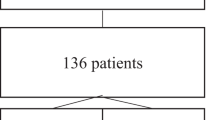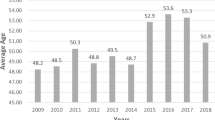Abstract
Study design
Retrospective study.
Objectives
To investigate the risk factors of tracheostomy and decannulation after cervical spinal cord injury (CSCI) and their epidemiological changes over the past 8 years in Beijing Bo’ai Hospital, China Rehabilitation Research Center (CRRC), China.
Setting
Beijing Bo’ai Hospital, CRRC.
Methods
We reviewed 8 years of patient data (2013.1.1 to 2020.12.31) at CRRC, focusing on those hospitalized and diagnosed with CSCI. We analyzed changes in demographic and clinical data’s trends. Logistic regression analysis was used to determine factors impacting tracheostomy and decannulation.
Results
Finally, 1641 CSCI patients met the inclusion criteria. Over the past 8 years, the proportion of tracheostomized patients with CSCI was 16.3%, and the proportion of successfully decannulated of tracheostomized patients with TCSCI was 77.9%. We found that Traumatic (OR = 1.8, 95% CI = 1.06, 3.22; p = 0.046), Motor level of injury (C5–C8) (OR = 0.32, 95% CI = −1.91,−0.34; p = 0.005), AIS = A/B/C (OR = 22.7/11.1/4.2, 95% CI = 12.16,42.26/5.74,21.56/2.23,7.89; p < 0.001/p < 0.001/p < 0.001), age > 56 (OR = 1.6, 95% CI = 1.04, 2.32; p = 0.031) were the risk factors for tracheostomy. By analyzing the risk factors of decannulation failure in tracheostomized patients with TCSCI through multivariable logistic regression, statistically significant differences were found in age > 45 (OR = 4.1, 95% CI = 1.44, 11.81; p = 0.008), complete injury (OR = 2.7, 95% CI = 1.26, 5.95; p = 0.011), facet dislocation (OR = 2.8, 95% CI = 1.13,7.07; p = 0.027).
Conclusions
Recent years have witnessed shifts in the epidemiological characteristics of CSCI. Identifying the factors influencing tracheostomy and decannulation in CSCI can aid in improving patient prognosis.
This is a preview of subscription content, access via your institution
Access options
Subscribe to this journal
Receive 12 print issues and online access
$259.00 per year
only $21.58 per issue
Buy this article
- Purchase on Springer Link
- Instant access to full article PDF
Prices may be subject to local taxes which are calculated during checkout



Similar content being viewed by others
Data availability
The dataset generated and analyzed during the current study is available from the corresponding author on reasonable request.
References
Injury GBDTB, Spinal Cord Injury C. Global, regional, and national burden of traumatic brain injury and spinal cord injury, 1990–2016: a systematic analysis for the Global Burden of Disease Study 2016. Lancet Neurol. 2019;18:56–87.
Aarabi B, Albrecht JS, Simard JM, Chryssikos T, Schwartzbauer G, Sansur CA, et al. Trends in demographics and markers of injury severity in traumatic cervical spinal cord injury. J Neurotrauma. 2021;38:756–64.
Golestani A, Shobeiri P, Sadeghi-Naini M, Jazayeri SB, Maroufi SF, Ghodsi Z, et al. Epidemiology of traumatic spinal cord injury in developing countries from 2009 to 2020: a systematic review and meta-analysis. Neuroepidemiology. 2022;56:219–39.
cite Chen C, Qiao X, Liu W, Fekete C, Reinhardt JD. Epidemiology of spinal cord injury in China: A systematic review of the chinese and english literature. Spinal Cord. 2022;60:1050–61.
Khan M, Prabhakaran K, Jehan F, Anderson P, Con J, Lombardo G, et al. Early tracheostomy in patients with cervical spine injury reduces morbidity and improves resource utilization. Am J Surg. 2020;220:773–7.
Jain NB, Ayers GD, Peterson EN, Harris MB, Morse L, O’Connor KC, et al. Traumatic spinal cord injury in the United States, 1993-2012. JAMA. 2015;313:2236–43.
Leelapattana P, Fleming JC, Gurr KR, Bailey SI, Parry N, Bailey CS. Predicting the need for tracheostomy in patients with cervical spinal cord injury. J Trauma Acute Care Surg. 2012;73:880–4.
Yugué I, Okada S, Ueta T, Maeda T, Mori E, Kawano O, et al. Analysis of the risk factors for tracheostomy in traumatic cervical spinal cord injury. Spine. 2012;37:E1633–8.
Harrop JS, Sharan AD, Scheid EH Jr, Vaccaro AR, Przybylski GJ. Tracheostomy placement in patients with complete cervical spinal cord injuries: American Spinal Injury Association Grade A. J Neurosurg. 2004;100:20–3. 1 Suppl Spine
Jiang B, Sun D, Sun H, Ru X, Liu H, Ge S, et al. Prevalence, incidence, and external causes of traumatic spinal cord injury in China: a nationally representative cross-sectional survey. Front Neurol. 2021;12:784647.
Sun GH, Chen SW, MacEachern MP, Wang J. Successful decannulation of patients with traumatic spinal cord injury: A scoping review. J Spinal Cord Med. 2022;45:498–509.
Li J, Liu G, Zheng Y, Hao C, Zhang Y, Wei B, et al. The epidemiological survey of acute traumatic spinal cord injury (ATSCI) of 2002 in Beijing municipality. Spinal Cord. 2011;49:777–82.
Liu H, Liu J, Shen M, Yang X, Du L, Yang M, et al. The changing demographics of traumatic spinal cord injury in Beijing, China: a single-centre report of 2448 cases over 7 years. Spinal Cord. 2021;59:298–305.
Mubashir T, Arif AA, Ernest P, Maroufy V, Chaudhry R, Balogh J, et al. Early versus late tracheostomy in patients with acute traumatic spinal cord injury: a systematic review and meta-analysis. Anesth Analg. 2021;132:384–94.
Foran SJ, Taran S, Singh JM, Kutsogiannis DJ, McCredie V. Timing of tracheostomy in acute traumatic spinal cord injury: A systematic review and meta-analysis. J Trauma Acute Care Surg. 2022;92:223–31.
Bach JR, Burke L, Chiou M. Conventional respiratory management of spinal cord injury. Phys Med Rehabil Clin N Am. 2020;31:379–95.
Long PP, Sun DW, Zhang ZF. Risk factors for tracheostomy after traumatic cervical spinal cord injury: a 10-year study of 456 patients. Orthop Surg. 2022;14:10–7.
Sun D, Zhao H, Zhang Z. Classification and regression tree (CART)model to assist clinical prediction for tracheostomy in patients with traumatic cervical spinal cord injury: a 7-year study of 340 patients. Eur Spine J. 2022;31:1283–90.
Wiefhoff J, Jansen O, Kamp O, Aach M, Schildhauer TA, Waydhas C, et al. Incidence and complications of cannula changes in long-term tracheotomized patients: a prospective observational study. Spinal cord. 2020;58:11–7.
Park J, Choi WA, Kang SW. Pulmonary rehabilitation in high cervical spinal cord injury: a series of 133 consecutive cases. Spinal Cord. 2022;60:1014–9.
Nakashima H, Yukawa Y, Imagama S, Ito K, Hida T, Machino M, et al. Characterizing the need for tracheostomy placement and decannulation after cervical spinal cord injury. Eur Spine J. 2013;22:1526–32.
Higashi T, Eguchi H, Wakayama Y, Sumi M, Saito T, Inaba Y. Analysis of the risk factors for tracheostomy and decannulation after traumatic cervical spinal cord injury in an aging population. Spinal Cord. 2019;57:843–9.
Kim DH, Kang SW, Choi WA, Oh HJ. Successful tracheostomy decannulation after complete or sensory incomplete cervical spinal cord injury. Spinal Cord. 2017;55:601–5.
Wilson JR, Vaccaro A, Harrop JS, Aarabi B, Shaffrey C, Dvorak M, et al. The impact of facet dislocation on clinical outcomes after cervical spinal cord injury: results of a multicenter North American prospective cohort study. Spine. 2013;38:97–103.
Mu Z, Zhang Z. Risk factors for tracheostomy after traumatic cervical spinal cord injury. J Orthop Surg. 2019;27:2309499019861809.
Kriz J, Kulakovska M, Davidova H, Silova M, Kobesova A. Incidence of acute spinal cord injury in the Czech Republic: a prospective epidemiological study 2006-2015. Spinal Cord. 2017;55:870–4.
Acknowledgements
We thank Prof. Li-Rong Liang & Dr. Pen-Kun Li for their statistical analysis assistance.
Funding
This work was supported by grants from China Rehabilitation Research Center (No. 2023ZX-Q12); National Natural Science Foundation of China, No. 82102676.
Author information
Authors and Affiliations
Contributions
LG was responsible for designing the review protocol, writing the protocol and report, conducting the research, screening potentially eligible patients, extracting and analyzing data, interpreting results, submitting the study to the ethics committee, updating reference lists and writing the first draft of the manuscript. WG was contributed to writing the report, extracting and analyzing data, interpreting results. HL and CHL were responsible for collecting data, analyzing data, graphing and creating tables. FY and WZH was responsible for arbitrating potentially eligible studies, revised the manuscript for important intellectual content. QW contributed to writing the report, providing important references and interpreting results. ZHT was responsible for supervising the research protocol and providing feedback on the report. He is the corresponding author. All authors approved the final manuscript.
Corresponding author
Ethics declarations
Competing interests
The authors declare no competing interests.
Ethical approval
Approval from the hospital ethics committee was obtained before commencing the study (No. CRRC-IEC-RF-SC-002-01).
Additional information
Publisher’s note Springer Nature remains neutral with regard to jurisdictional claims in published maps and institutional affiliations.
Rights and permissions
Springer Nature or its licensor (e.g. a society or other partner) holds exclusive rights to this article under a publishing agreement with the author(s) or other rightsholder(s); author self-archiving of the accepted manuscript version of this article is solely governed by the terms of such publishing agreement and applicable law.
About this article
Cite this article
Gao, L., Gao, W., Liu, H. et al. Long-term trends and risk factors of tracheostomy and decannulation in patients with cervical spinal cord Injury. Spinal Cord (2024). https://doi.org/10.1038/s41393-024-00968-9
Received:
Revised:
Accepted:
Published:
DOI: https://doi.org/10.1038/s41393-024-00968-9



